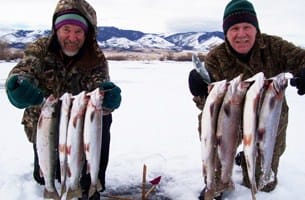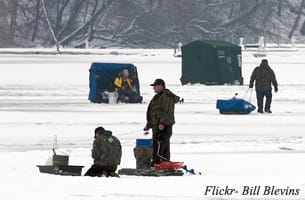
There’s something magical, and even a bit surreal, about walking out on a frozen lake, drilling or chopping a hole through the ice, lowering a line down into the depths and pulling a fish to the frozen surface.
In recent decades, gas driven ice augers, snowmobiles, pop-up ice shanties and electronic fish finding equipment have changed the face of ice fishing. But you don’t need any of that stuff to be successful and enjoy one of the most simple and elemental types of fishing. All you really need are warm clothes, a hand auger or spud, a jigging rod and/or a handful of tip-ups or traps, as they’re called in New England.
If you’re just getting started, the best advice I can give you is to head to a popular ice fishing spot and, after making sure the ice is safe, take a walk around and visit with other fishermen. Ninety-nine percent of them are friendly, glad to have somebody stop by and talk with and, in my experience, all too happy to share their knowledge. Tell an ice fisherman you’ve never ice fished before but want to get started, and you may end up with a new friend and fishing buddy.
Live bait, in the form of minnows, shiners or suckers (where they are legal), is a favorite with tip-up fishermen. When live bait fish aren’t legal, night crawlers, salted minnows, Gulp baits, cheese balls, salmon eggs, grubs and maggots are popular. Bigger baits usually mean bigger fish. While trout, pickerel, perch and crappie anglers favor smaller minnows, pike and muskie anglers are partial to eight and 10-inch suckers. And little jigs, spoons and ice flies tipped with grubs, maggots and perch eyes are great pan fish baits.
In my opinion, not much compares with the excitement of seeing a flag pop up and then, running across the ice to find your line being stripped off your spool by a fish taking your bait. But for really fast action, especially on pan fish, jigging rods can’t be beat. Take your jigging rod and find a school of perch or crappies, and you can have the fixings for a fish fry flopping on the ice in a matter of minutes.

On a lake I often fish in Montana, ice shanties are the exception and not the rule. Fishermen stand out on the ice or sit on chairs watching their rods and tip-ups. From sunup to sundown on a good day, we may constitute a village of 300-400 happy souls out enjoying ourselves: drinking coffee, eating sandwiches, barbecuing brats and burgers and sharing stories until somebody yells “Flag!” or “Your rod just bounced.” Sometimes it’s a rainbow trout, sometimes a yellow perch or even a walleye. Shouts of encouragement and congratulations ring out when a fish comes through the hole, and audible moans ring across the ice when a fish is lost at the last moment.
The best thing about ice fishing is that it gets you outdoors on a winter’s day and connects you with friends, family and other anglers. It provides you an opportunity to visit, swap stories and catch a mess of fish for the table. And trust me — at the end of the day, when you return home, you’ll be really grateful for a hot meal and warm bed!



